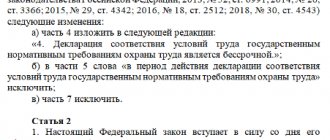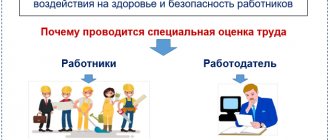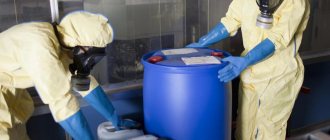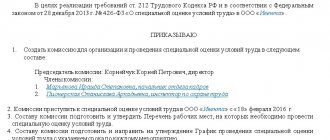What is a special assessment of working conditions
This is a set of measures, the purpose of which is to establish the presence of harmful factors in each workplace and assign it a risk class.
This is stated in Article 1 of the Federal Law of December 28, 2013 No. 426-FZ “On Special Assessment of Working Conditions” (hereinafter referred to as the Law on SOUT). There are four risk classes:
- Optimal (1.0): dangerous and (or) harmful production factors are either completely absent or are at a level that is safe for humans. The prerequisites have been created to maintain a high level of performance.
- Acceptable (2.0): there are dangerous and (or) harmful factors, but their impact does not exceed the levels established by hygiene standards. The altered functional state of the body is restored during rest, at the beginning of the next working day or shift.
- Harmful (3.0): levels of exposure to negative factors exceed the standard. It is divided into subclasses: first degree (3.1), second degree (3.2), third degree (3.3) and fourth degree (3.4).
- Dangerous (4.0): levels of exposure to negative production factors can create a threat to the life of an employee, and the consequences can lead to the development of an occupational disease.
The results of the SOUT are used, among other things, when assigning discounts and surcharges to the rate of contributions “for injuries” and additional tariffs for pension contributions. Employees who work in workplaces classified as hazardous (subclasses 3.2, 3.3 and 3.4) or hazardous classes are granted additional leave (Article 117 of the Labor Code of the Russian Federation). For classes 3.0 and 4.0, a salary increase of at least 4% of the salary or rate is provided (Article 147 of the Labor Code of the Russian Federation). There are other benefits as well.
Calculate “complex” salaries with coefficients and bonuses for a large number of employees
Advantages of cooperation with SOTARM LLC
Our organization for conducting a special assessment of working conditions conducts periodic retraining of employees to improve their professionalism and qualifications. The main focus is on improving the quality of services provided and ensuring competitiveness. To do this, each customer receives an individual approach, taking into account his financial and property status.
In order to reduce the cost of orders, the company's management constantly optimizes the process of providing services. All work is carried out promptly so as not to interfere with production. Laboratory equipment, devices, instruments undergo periodic reference testing.
Who may not conduct an assessment of working conditions
SOUT is not mandatory for the following categories:
- organizations and individual entrepreneurs who have not concluded a single employment contract;
- employers - individuals without individual entrepreneur status;
- employers - religious organizations.
All employers, without exception, have the right to refuse SOUT in relation to the workplaces of homeworkers and remote workers (Part 3 of Art. Law on SOUT).
ATTENTION. Vacant positions are not subject to special assessment. The fact is that in the absence of employees, it is impossible to analyze their working conditions.
If the SOUT is completed before the end of 2018.
This year, the special assessment of conditions must be taken especially seriously, because this is the last year for the work to be carried out in full. The management of enterprises is entrusted with the responsibility for carrying out SOUT, and it does not matter what kind of production it is (engineering, construction, couriers or storekeepers).
The employment contract must stipulate working conditions and the citizen must be familiar with them before employment. Based on the requirements of legislative acts, SOUT does not need to be carried out if citizens are working from home.
Who conducts a special assessment of working conditions
SOUT is carried out by a specialized third-party company with the participation of a commission created by the employer.
The commission includes: representatives of the employer and trade union organization (if it is created at the enterprise), an occupational safety specialist (see “How to become an occupational safety specialist”). It also needs to include the head of a small enterprise or individual entrepreneur. The head of the commission is appointed by the employer himself or his representative.
Compose HR documents using ready-made templates for free
The specialized third party company must meet the following criteria:
- SOUT is its main activity.
- The appropriate accreditation has been obtained.
- The staff includes at least 5 experts who have a certificate to perform special assessment work. At least one expert is a doctor in general hygiene (or occupational hygiene) or a doctor in sanitary-hygienic laboratory research.
- There is a testing laboratory accredited to measure harmful and dangerous factors in the production environment and the labor process.
Duration of validity of documents and reports
How long are reporting documents for a special assessment of working conditions valid? Typically this duration is five years. But there are some exceptions:
- If the workplace is modernized and new equipment is purchased, then the results of the SOUT will not be valid.
- When the workplace is moved to another facility, the existing results of the SOUT cannot be applied, but it is necessary to re-enter into an agreement with an expert organization.
Procedure for carrying out SOUT
Before starting the procedure, it is necessary to draw up a work schedule and a list of jobs that are subject to a special assessment. The form of these documents is free.
REFERENCE. SOUT is carried out in relation to the workplace, not the position. Therefore, if one person combines several positions at once, then you need to check how many jobs he actually occupies. And include each one in the list.
Further research is carried out within the framework of SOUT. Based on their results, a report is compiled. It is signed by specialists from an accredited third-party organization and members of the commission. At the same time, a card is filled out for each workplace (report forms and cards approved by order of the Ministry of Labor dated January 24, 2014 No. 33n). Employees should be familiarized with the card against signature within 30 calendar days from the date of approval of the report. Within the same period, summary data of the special assessment must be published on the employer’s official website (if available).
In addition, a declaration of compliance with working conditions is drawn up (the form and procedure for submission approved by order of the Ministry of Labor dated 02/07/14 No. 80n). It includes information about workplaces where harmful and dangerous production factors have not been identified, and working conditions are recognized as optimal and acceptable. The declaration must be submitted to the territorial labor inspectorate no later than 30 working days after approval of the report based on the results of the special labor inspection. The declaration can be submitted online on the Rostrud website. To do this, it must be signed with a qualified electronic signature.
Receive an enhanced qualified electronic signature certificate in an hour
Preparatory stage
At this stage, the employer compiles a list of workplaces where the SAW will end in the next 6 months and technological equipment and raw materials will be replaced. This document will form the basis of the technical specifications that are attached to the special assessment agreement.
At the same time, specialists of the customer company prepare the following documents:
- order to conduct SOUT. An assessment schedule and the composition of the commission are attached to it;
- information about the company indicating the postal address, bank details;
- a list of disabled employees who work at the enterprise;
- list of personnel who are subject to medical examination;
- information about the availability of SNILS for each company employee;
- a list of personnel who have monetary compensation, financial and property guarantees, as well as employees with early retirement;
- list of technological equipment, lifting machines, tools at workplaces.
The assessment contract signed by both parties consists of 16 sections and the following 8 appendices:
- technical task;
- assessment schedule;
- act of acceptance of completed work;
- act of reconciliation of mutual payments for services rendered;
- order to conduct special assessment;
- information about the customer company;
- list of jobs that are subject to assessment;
- list of materials, raw materials, equipment, tools used at the inspected workplaces.
If the assessment is carried out at state or municipal enterprises, then they are required to use a standard contract and all the necessary annexes to it. This is provided for in Federal Law No. 44-FZ of 04/05/2013. Private and non-state companies can draw up a contract at their discretion.
Timing and frequency of carrying out SOUT
The last stage of the special assessment was completed by January 1, 2019 (Part 6 of Art. Law on SOUT). It is assumed that by this date all employers have carried out the above activities and submitted the declaration on time.
When should the next SOUT procedure be scheduled? In general, this must be done no later than 5 years after approval of the report based on the results of the previous special assessment. Upon completion of the next special assessment, you must fill out the declaration again.
But if there were no accidents or occupational diseases during the five-year period, the validity of the declaration is automatically extended for another 5 years. The next SOUT is also postponed for the same period. There is no need to document such a deferment (letter of the Ministry of Labor dated August 30, 2019 No. 15-1/OOG-1968).
In 2021, special conditions apply. If the validity period of the SOUT results ends in the period from April to September 2021, then it is extended until October 1, 2021 (Resolution of the Government of the Russian Federation dated June 11, 2020 No. 849; see “Validity periods have been extended for SOUT results”).
IMPORTANT. When a new workplace appears, it is necessary to organize an unscheduled special assessment. This must be done within 12 months from the date it was put into operation.
What deadlines are set for eliminating violations?
Based on the special assessment of working conditions, the following documents are prepared:
- special assessment cards for working conditions;
- protocol for measuring work area air, noise, lighting, microclimate;
- protocol for injury hazard and provision of personal protective equipment (PPE);
- measures to improve working conditions.
Violations based on the results of the SOUT must be eliminated before the next inspection
Deadlines are given for the implementation of the event items, namely:
- If eliminating the violation does not require any material or physical costs, then it can be done immediately upon receipt of the document. For example, there is no label with a voltage indicator attached to the outlet. It really does work quickly.
- When an event is planned that requires significant investment, the time frame for elimination increases. For example, reconstruction of the ventilation and air conditioning system. In this case, experts first consult with the administration of the organizational structure about what deadlines to set.
A special assessment is carried out every five years and the employees who carried out this event check how the plan they proposed was implemented and how the condition of the workplace was improved. But it is wrong to understand that the implementation of planned measures can be stretched over five years; everything must be carried out in a timely manner.
The cost of the special assessment and who pays for it
The law does not regulate the cost of the procedure. The price depends on a number of factors: market conditions, size of the organization, number of staff, etc. On average, SOUT for one place costs from 600 rubles. Most accredited companies have set a lower price threshold: even if a special assessment needs to be carried out for a small number of jobs, for example, one or two, you will have to pay at least 10,000 rubles for the procedure.
As a general rule, the employer must finance the entire range of measures for a special assessment of working conditions. But he can reimburse a certain amount through contributions for insurance against industrial accidents and occupational diseases. It is permissible to direct part of such contributions to the prevention of injuries and occupational diseases, including to the SOUT (see “The procedure for reimbursement of expenses for the reduction of injuries and occupational diseases has been changed”).
Definition
A special assessment of working conditions (SOUT) is a system of thorough inspection of production, which reveals the harmful effects of the technological process on nature and humans. To do this, biological, chemical, physical parameters of the environment and other factors with negative impacts are studied.
The organization and conduct of SOUT are regulated by the Labor Code and Law of the Russian Federation No. 426-FZ of December 28, 2013, which was amended in 2020. It describes in detail the employer's responsibilities to ensure the safety of personnel in the process of fulfilling labor obligations. A special assessment at each workplace is carried out at least once every 5 years.
Violation of the special assessment procedure or its absence may result in the imposition of an administrative fine from 60,000 to 80,000 rubles. per enterprise and from 5,000 to 10,000 rubles. to the leader.
To avoid these unpleasant consequences, we recommend contacting the Labor Protection and Workplace Certification Service LLC (SOTARM), which specializes in carrying out SOUT. The company is included in the register of organizations conducting a special assessment of working conditions. Registered in the national accreditation system.
After concluding an agreement for the provision of such a service, LLC specialists begin an assessment, which is carried out in several stages. They have a mandatory sequence, which is not allowed to be violated.
Sequencing
In order to conduct an SOUT in accordance with all legal requirements, you should carefully study the legislative norms. All special assessment activities can be arranged in three stages:
Preparatory stage
Before experts begin studying and assessing dangerous and harmful production factors, the employer and the appraiser company are required to fulfill their set of responsibilities:
Main stage
At this stage, the appraiser company carries out a set of special appraisal activities using a special methodology.
The nuances of the work of the appraiser company’s experts:
After completion of all studies and assessments, working conditions in terms of the degree of harmfulness and (or) danger are assigned to certain classes (subclasses).
To arrive at a final assessment of working conditions, the entire set of factors is taken into account:
The results of the activities carried out are reflected in the report, which is approved by the chairman of the SOUT commission after all its members have signed it.
The final stage
The employer has a lot of troubles at this stage:
The appraiser company is legally limited in terms of:
Employees whose working conditions are considered dangerous or harmful under the terms of a special assessment must undergo regular preventive medical examinations (Order of the Ministry of Health and Social Development dated April 12, 2011 No. 302n).
How long should special assessment materials be stored?
There are different deadlines for reporting, storage and action.
Report deadline
Simultaneously with the formation of the commission, an order from the employer is issued, which stipulates the deadlines for drawing up the report.
Report storage period
For production facilities where no hazards have been identified (classes 1 and 2), the shelf life is 45 years. For enterprises with hazard classes 3 and 4, the period increases to 75 years. If the enterprise has changed the harmfulness of production from optimal and acceptable (classes 1 and 2) to harmful and dangerous (classes 3 and 4), then the shelf life is counted from the moment of the last SOUT.
Validity period of SOUT materials
The validity period of the SOUT in the organization is the same as the validity period of the declaration submitted to the labor inspectorate. Both of these periods correspond to the duration of the hazard class that was established during the last special inspection.
What will they be punished for?
Those employers who do not organize the implementation of SOUT or do so in violation of the legally established procedure will inevitably face punishment.
Fines:
Starting from 2021, employers will be under double control - for failure to carry out special labor regulations or violation of the procedure for its implementation, fines will be assessed not only based on the results of inspections carried out by labor inspectors, but also automatically.
The FSIS SOUT system will identify violators by comparing data from different sources with the information available in the system. For example, the program will compare data on the registration period of employers with data on the special assessment they conducted. If more than a year has passed since the company was registered, and the system has not received data on the special assessment, an automatic fine will follow for failure to carry out the special assessment.
The following articles will introduce you to the features of different types of control:
- “What are the features of audited financial control?”;
- "Bodies and agents of currency control and regulation in the Russian Federation";
- “Tax control in the Russian Federation: forms, methods and types”.
Fines
Each of the above actions is mandatory; failure to perform any of them or violation of deadlines is punishable by fines. For officials, fines reach 10,000 rubles, for legal entities - 80,000 rubles. To avoid any grounds for liability, the company confirms each action within the framework of the assessment, for example, notifying the executing organization - with a notification of delivery of a letter, GIT - with the signature of its representative. The most efficient method seems to be courier delivery to the labor inspectorate, so you will be sure that your declaration is registered.
The entire “Summary Data” document is posted on your company’s website (if it has one) in scanned form with the signatures of the commission members.
Despite the multi-step nature of this procedure, it is not difficult to conduct a special labor assessment, since the performing companies provide documentary support and accompany the process at all stages of the work.









